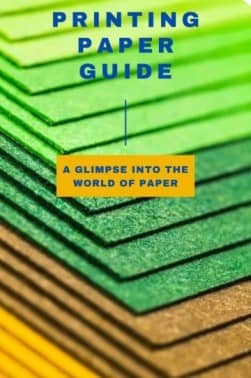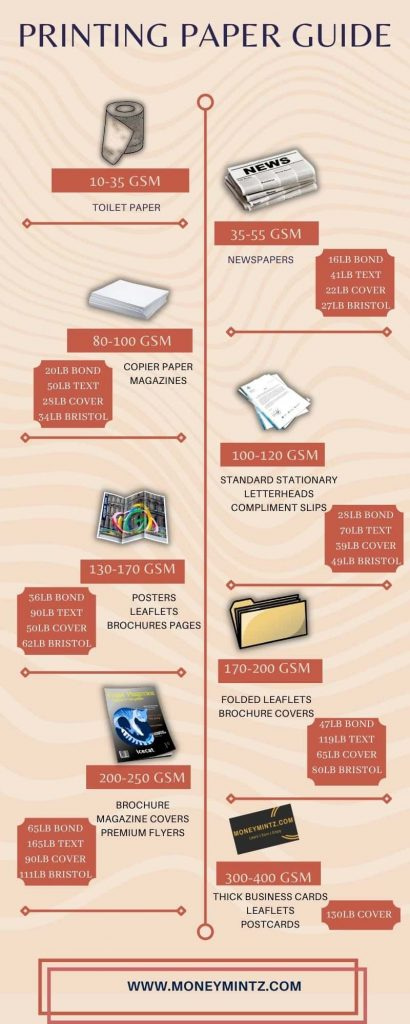If we look at printing as a business venture, it is entirely based on paper. This printing paper guide shows how printing paper businesses have been thriving out of the paper industries since the digital revolution invaded our lives.
As a matter of fact, the quality of the print depends on the quality of paper used. So choosing the perfect paper for your project from a variety of papers is certainly important.
However, what is more essential, is the knowledge required to decide which paper will suit your project the best.
Be it projects that need to be completed on an urgent basis within a limited span of time, creative design projects or variable data/imaging and direct mail projects; the type of paper used while printing defines their textual and visual layout.

This should be a thoroughly thought-through choice, which will vary depending on the type of product that is being printed.
It is a tedious process to select a single suitable layout out of a range of paper layouts available.
As a matter of fact, each type of paper belongs to a particular weight, a finish and a processing type.
The guidelines created around the subject help in determining the transparency, weight, appearance, thickness, feel, durability and level of opaqueness.
This guide will cover these types of preliminary concepts and further explore in detail the necessities and uses of printing paper.
However, before we indulge in the intricacies of the topic, there are some terminologies that you should be aware of.
Here is a gist of the basics that you need to know about when looking for printing paper.
DISCLAIMER: PaperCanyon is reader-supported. If you make a purchase through links on our site, we may sometimes earn a commission at no additional cost to you. As an Amazon Associate, we earn from qualifying purchases.
What’s the buzz about printing papers?
Printing paper is another term for any sort of paper which can be used in printing devices.
It can be your day-to-day A4 size paper, or other types of paper with unique, diverse qualities such as that in newspapers, catalogs, books and magazines, notebooks, business forms, commercial printing and digital printing.
We will get into the depths of it after scratching on the surface with terminologies related to printing paper.
What is a paperweight, and why should you care?
The technical definition of the term grammage, or weight defined the weight of a sheet of paper in an area of one square meter.
In mathematical terms, paperweight could be defined as the ratio between the weight of a sheet of paper and its area.
The unit term used to measure the weight of paper is grams per square meter, acronymized to gsm or just grams (g).
Paper is measured through this standardized unit in various paper industries and corporations. Different types of paper belong in different categories of gsm paper.
For example, uncoated paper, also known as photocopy paper carries its weight somewhere between 60 gsm and 90 gsm.
On the other hand, a paperboard weighs anywhere between 150 gsm up to as high as 350 gsm.
Grammage of the paper primarily determines two characteristics of the paper, which could or could not be only used for printing:
- Texture
The texture of the printing paper, as in the way the outward layer of a sheet of printing paper feels when one runs their hand through its surface, affects the weight or grammage of paper.
- Transparency
If you are working with papers that weigh comparatively higher (for example, 350 gsm) then their transparency will be lower than papers that have a lower weight to area ratio.
Now that you know about the unit measurement of paper – gsm – you must be wondering if there is a difference between the weight of a paper and its thickness.
Is the thickness of paper the same as the weight of paper? Let’s find out.
Thickness of Paper versus Weight of Paper
The thickness of a sheet of paper, or caliper is NOT the same as the weight of paper.
It is important to be able to distinguish between the two. Higher weights usually mean a thicker quality of a sheet of paper.
There are various other factors that can also have an impact on the thickness and weight of paper altogether. These include:
- The Type of Processing Being Done
The different types of processing techniques being used by the paper maker can provide a higher density to paper of the same grammage. This suggests that a lower density of paper would produce a thicker sheet of paper.
- Wood Fiber Content Present
Paper is made by contracting wood fibers out of fibers of trees.
This fiber is obtained either through chemical processes (cellulose) or mechanical processes (by using wood pulp).
High wood fiber content would mean a thicker quality of the paper being produced.
- Additives
In order to make the texture of printing paper more appealing or in order to achieve some tactile and visual special effects, papermakers add some substances to the wood pulp.
This is a pollution-free and eco-friendly way of engaging with printing paper.
An example of that would be Laguna paper, which is environment friendly. Laguna paper is constructed out of seaweed from the Venice Lagoon.
Other such types of eco-friendly printing papers have been constructed out of ingredients such as coffee, oranges, maize and olives.
By now, it must be clear for you that two types of the printing paper that weigh the same can have varying thicknesses. This would primarily depend on the composition of the printing paper and the various types of processing techniques being used.
Let’s Get Virtual!
If you would like to delve deeper into the concept of gsm paper and learn more about it, then here is a YouTube link to a short video that will help you understand in further depth the purpose and functioning of gsm paper.
“The Easy Way to Understand the Thickness of Your Paper”
In this YouTube video, you will learn why it is so important to consider the thickness of any type of paper, including printing paper in less than two minutes.
For the purpose of understanding and demonstration, sticky notes are recommended.
Throughout the video, the thickness of most of the types of paper is described by pairing these sticky notes together.
Moreover, you will learn in detail the categorical distinction between various types of gsm papers.
Weighing’ Around: Why Wait Till We Weigh?
Be it business cards, invites or flyers, all standards of paper have a recommended weight that all the paper-related industrial corporations rely upon.
It would only be true to say that the final essence of your graphic design or other form of art is determined after printing or publishing it on the right type of paper.
For example, if you print a cataloge paper with low grammage, then there is a high probability that the pages will be translucent and the images and words on one side of the printing paper would vaguely yet easily pop out to the other side.
Thus, it is important to determine the weight of printing paper as soon as you decide the purpose that it will serve.
Just a Suggestion:
You must have come across the PixartPrinting website. It has various suggestions when it comes to paper weight based on the category of product being questioned.
An easy example of demonstrating this phenomenon would be when you are getting your business cards printed.
We personally recommend you to print a business card with a grammage of 280 gsm, 300 gsm or 350 gsm.
You will still have the liberty to decide the grammage or weight of the paper that you prefer.
What is the Weight-based Categorization of Paper?

If you are looking for different types of paper categorized based on their weight, then you have come to the right place.
We have made the process simpler for you by compiling all the necessary and important information about printing paper belonging to different weight-to-area ratios.
You can shortlist the sort of paper that would best suit your requirements by going through the mini-guide presented below:
90 GSM – 120 GSM
The copier paper or printer paper that is commonly used in offices has its weight lying between 80 gsm to 100 gsm.
Other stationery items such as compliment slips and letterheads are printed on paper with a weight of 100 gsm to 120 gsm.
This is a commonly used type of paper and is also referred to as offset paper.
Another remarkable quality of this type of paper is that it soaks up color well due to its uncoated rough surface and high brightness.
This type of printing paper can be printed and written on consistently and repeatedly with no damage done to the quality and texture of the paper.
130 GSM – 170 GSM
This type of paper weight is best for creating posters and UV resistance. Its hardwearing weatherproof quality makes it an easy go-to option for outdoor activities. The thicker side of 130 gsm to 170 gsm category of printing paper offers the best paper weight perfect for flyers, brochure pages and leaflets.
The water-based coating on this type of printing paper makes it difficult to write on it as the texture of this paper is almost as smooth as silk.
The finishing of 130 gsm to 170 gsm of paperweight provides an extra coating of stability by sealing the color and is ideal for printing high-quality images.
200 GSM – 300 GSM
This range of paper consists of a sturdy texture of paper with a weighty appeal.
It is the ideal paper weight for constructing premium quality flyers and brochure covers.
However, if you are considering direct mail campaigns, then we recommend that you go for printed products that weigh comparatively lighter. This is because the weight of the type of printing paper chosen has an impact on the delivery charges.
If you are looking for proper paper material to be used in banners, then this lightweight yet robust category of printing paper will make for the perfect material. Moreover, its resistance to wear and tear makes it all the more reliable and feasible.
300 GSM – 400 GSM
If you are looking for the thickest, least translucent premium quality of paper, then this category of paperweight is ideal for your services. These are primarily used in high-quality business cards, leaflets, postcards, wedding stationery and even presentation folders.
This impressively thick style of paper can sturdily stand on its own weight and flaunt its robustness onto the hands of whoever is holding it. If you are looking for a superior quality finish, then the ideal paper weight that would serve that purpose is 400 gsm.
Let’s get virtual!
If you are printing your virtual or digital design onto a sheet of printing paper, then a tremendous amount of its aesthetics would rely on the type and quality of printing paper being used. Especially when it comes to various types of paper crafts. And certainly when it comes to technical devices, a guide is crucial for you to help you not mess up your design. Keeping that in mind, here is a link to a YouTube video that will provide you with some important key tips that you should keep in mind while printing a digitalized work of art.
“Basic Tips to Print Digital Papers for Crafting | Tutorial”
In this YouTube tutorial, you will learn some preliminary and handy tips that would help you through the process of printing digital paper for crafting.
Crating may not be everybody’s cup of tea, but it sure is spectacularly unique in its own way.
Therefore, things such as having enough ink in your printer, having a loaded deck of papers, and some easily digitally available prints of papers are discussed.
Moreover, you will also learn the specifications that you would have to type in while printing a design on printing paper.
Frequently Asked Questions (FAQs):
Are the weight and thickness of paper the same?
No, the weight and thickness of paper are not the same. Most of the paper industries do a quality check on papers via considering the weight, or grammage of paper rather than its thickness. This is done as two sheets of paper may have different thickness, but vary in their weight. Therefore, to nullify that error papermakers only consider the weight of paper.
What is the thickest type of gsm printing paper?
The thickest type of gsm printing paper lies in between the range of 300 gsm to 400 gsm. This is the sturdiest and most superior quality of paper that one could find in current paper-related industries.
Can papers of different thicknesses have the same weight?
Yes, two sheets of printing papers of the same thickness may also have the same weight. In order to avoid confusion of such sorts, paper makers resort to measuring the quality of paper through its weight rather than thickness.
What is the thinnest type of gsm printing paper?
The thinnest type of gsm printing paper lies in between the range of 90 gsm to 120 gsm. This category of paper includes the everyday printer paper or copier paper and is used in bulk for various office-related work and even at educational institutions and other corporations based out of other professions.
What is the unit measurement for printing paper?
The unit measurement for printing paper is either grams per square meter (gsm) or just grams (g). The technical definition of the term grams per square meter is the weight of a sheet of paper at an area of one square meter.
Which type of gsm paper is used for making business cards?
The ideal weight of a gsm paper should lie anywhere in between 300 gsm to 400 gsm if you want to make some fine looking stylized business cards out of it, The primary reason behind doing this is that printing paper belonging to this category is the most sturdy, least transparent and of superior quality material when compared to other distinctions of paper.
Conclusion
We are occupying the digital era in all its glory. When it comes to printing paper, a whole lot of its design, texture and form depends on the paper it is being printed on.
You would definitely not like a paper advertisement on which you can see the images at back popping out vaguely on the front side.
Therefore, to conclude, it is important to have the knowledge of which paper suits which type of work. If that were not the case, then we would have flappy business cards, see-through invites and low-quality advertisements.
If you want more information on the types of paper for printing, you can check the website bbpress.co.uk.
So if we want the best of everything, then let’s make the best out of printing paper as well. So what are you waiting for? Let your exploration of paper world begin.

Avni Deopura
Content Writer
An SEO Expert, a Prolific Content Writer, and a dreamer currently pursuing a postgraduate degree in Master of Science in Psychology from St. Joseph’s College of Arts and Science. She is working as a Content Producer and Social Media Analyst.
End of – “A Glimpse into the World of Paper: A Printing Paper Guide”






